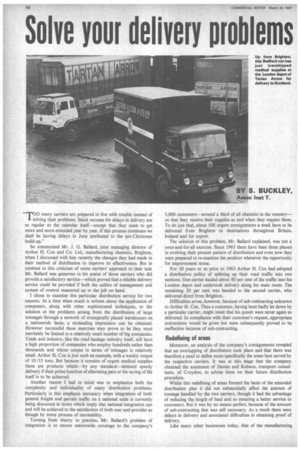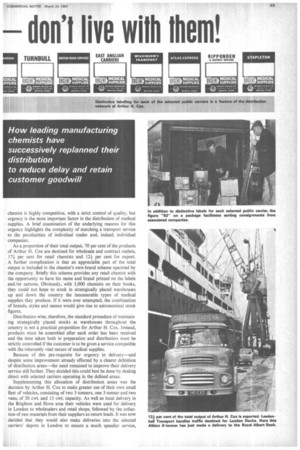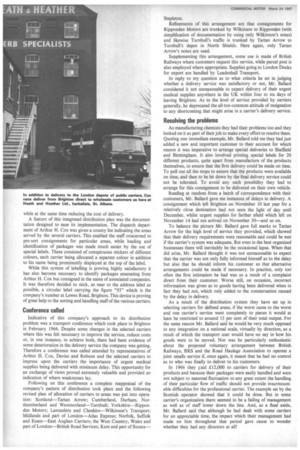Solve your delivery problems don't live with them!
Page 50

Page 51

Page 52

If you've noticed an error in this article please click here to report it so we can fix it.
" TOO many carriers are prepared to live with trouble instead of solving their problems. Stack excuses for delays in delivery are as regular as the calendar itself—except that they seem to get more and more extended year by year. If this process continues we shall be .having delays in June attributed to the pre-Christmas build-up."
So commented Mr. J. G. Ballard, joint managing director of Arthur H. Cox and Co. Ltd., manufacturing chemists, Brighton, when I discussed with him recently the changes they had made in their method of distribution to improve its effectiveness. But in contrast to this criticism of some carriers' approach to their task Mr. Ballard was generous in his praise of those carriers who did provide a satisfactory service—which proved that a reliable delivery service could be provided if both the calibre of management and system of control measured up to the job on hand.
I chose to examine this particular distribution service for two reasons. At a time when much is written about the application of computers, along with other sophisticated techniques, to the solution of the problems arising from the distribution of large tonnages through a network of strategically placed warehouses on a nationwide basis, a misleading impression can be obtained. However successful these exercises may prove to be they must inevitably be limited to a relatively small number of big companies. Trade and industry, like the road haulage industry itself, still have a high proportion of companies who employ hundreds rather than thousands and whose output in terms of tonnages is relatively small. Arthur H. Cox is just such an example, with a weekly output of 10/15 tons. But because it consists of urgent medical supplies these are products which—by any standard—demand speedy delivery if their prime function of alleviating pain or the saving of life itself is to be achieved.
Another reason I had in mind was to emphasize both the complexity and individuality of many distribution problems. Particularly is this emphasis necessary when integration of both general freight and parcels traffic on a national scale is currently being discussed in terms which imply that national integration can and will be achieved to the satisfaction of both user and provider as though by some process of inevitability.
Turning from theory to practice, Mr. Ballard's problem of integration is to ensure nationwide coverage to the company's 5,000 customers—around a third of all chemists in the country— so that they receive their supplies as and when they require them. To do just that, about 500 urgent consignments a week have to be delivered from Brighton to destinations throughout Britain, Ireland and for export.
The solution of this problem, Mr. Ballard explained, was not a once-and-for-all exercise. Since 1963 there have been three phases in evolving their present pattern of distribution and even now they were prepared to re-examine the position whenever the opportunity for improvement arose.
For 10 years or so prior to 1963 Arthur H. Cox had adopted a distribution policy of splitting up their road traffic into two sections. One carrier hauled about 80 per cent of the traffic into his London depot and undertook delivery along his main route. The remaining 20 per cent was handed to the second carrier, who delivered direct from Brighton.
Difficulties arose, however, because of sub-contracting unknown to Arthur H. Cox. Thus a customer, having been badly let down by a particular carrier, might insist that his goods were never again so delivered. In compliance with their customer's request, appropriate instructions would be given but were subsequently proved to be ineffective because of sub-contracting.
Redefining of areas
Moreover, an analysis of the company's consignments revealed that an overlapping of distribution took place and that there was therefore a need to define more specifically the areas best served by the respective carriers. It was at this stage that the company obtained the assistance of Davies and Robson, transport consultants, of Croydon, to advise them on their future distribution procedure.
Whilst this redefining of areas formed the basis of the amended distribution plan it did not substantially affect the amount of tonnage handled by the two carriers, though it had the advantage of reducing the length of haul and so ensuring a better service to customers. But it was by no means perfect, because of the amount of sub-contracting that was still necessary. As a result there were delays in delivery and associated difficulties in obtaining proof of delivery.
Like many other businesses today, that of the manufacturing, chemist is highly competitive, with a strict control of quality, but urgency is the most important factor in the distribution of medical supplies. A brief examination of the underlying reasons for this urgency highlights the complexity of matching a transport service to the peculiarities of individual trades and, indeed, individual companies.
As a proportion of their total output, 70 per cent of the products of Arthur H. Cox are destined for wholesale and contract outlets, 17; per cent for retail chemists and 12+ per cent for export. A further complication is that an appreciable part of the total output is included in the chemist's own-brand scheme operated by the company. Briefly this scheme provides any retail chemist with the opportunity to have his name and brand printed on the labels and/or cartons. Obviously, with 5,000 chemists on their books, they could not hope to stock in strategically placed warehouses up and down the country the innumerable types of medical supplies they produce. If it were ever attempted, the combination of brands, styles and names would give rise to astronomical stock figures.
Distribution-wise, therefore, the standard procedure of maintaining strategically placed stocks at warehouses throughout the country is not a practical proposition for Arthur H. Cox. Instead, products must be assembled after each order has been received and the time taken both in preparation and distribution must be strictly controlled if the customer is to be given a service compatible with the inherently vital nature of medical supplies.
Because of this pre-requisite for urgency in delivery—and despite sonic improvement already effected by a clearer definition of distribution areas—the need remained to improve their delivery service still further. They decided this could best be done by dealing direct with selected carriers operating in the defined areas.
Supplementing this allocation of distribution areas was the decision by Arthur H. Cox to make greater use of their own small fleet of vehicles, consisting of two 5-tonners, one 3-tonner and two vans, of 30 cwt. and 15 cwt: capacity. As well as local delivery in the Brighton and Hove area their vehicles were used for delivery in London to wholesalers and retail shops, followed by the collection of raw materials from their suppliers as return loads. It was now decided that they would also make deliveries into the selected carriers' depots in London to ensure a much speedier service, while at the same time reducing the cost of delivery.
A feature of this integrated distribution plan was the documentation designed to ease its implementation. The dispatch department of Arthur H. Cox was given a county list indicating the areas served by the several carriers. This enabled the staff concerned to pre-sort consignments for particular areas, while loading and identification of packages was made much easier by the use of special labels. These consisted of conspicuous stickers of different colours, each carrier being allocated a separate colour in addition to his name being prominently displayed at the top of the label.
While this system of labelling is proving highly satisfactory it has also become necessary to identify packages emanating from Arthur H. Cox but consigned in the name of associated companies. It was therefore decided to stick, as near to the address label as possible, a circular label carrying the figure "93" which is the company's number at Lewes Road, Brighton. This device is proving of great help to the sorting and handling staff of the various carriers.
Conference called
Indicative of this company's approach to its distribution problem was a transport conference which took place in Brighton in February 1966. Despite some changes in the selected carriers where this was felt necessary to improve the service, reduce costs or, in one instance, to achieve both, there had been evidence of some deterioration in the delivery service the company was getting. Therefore a conference was called attended by representatives of Arthur H. Cox, Davies and Robson and the selected carriers to impress upon the carriers the importance of urgent medical supplies being delivered with minimum delay. This opportunity for an exchange of views proved extremely valuable and provided an indication of where weaknesses lay.
Following on this conference a complete reappraisal of the company's pattern of distribution took place and the following revised plan of allocation of carriers to areas was put into operation: Scotland—Tartan Arrow; Cumberland, Durham, Northumberland and Westmorland—Turnbull; Yorkshire—Ripponden Motors; Lancashire and Cheshire—Wilkinson's Transport; Midlands and part of London—Atlas Express; Norfolk, Suffolk and Essex—East Anglian Carriers; the West Country, Wales and part of London—British Road Services; Kent and part of Stssex Stapleton.
Refinements of this arrangement are that consignments for Ripponden Motors are trunked by Wilkinson to Ripponden (with simplification of documentation by using only Wilkinson's notes) and likewise Turnbull's traffic is trunked by Tartan Arrow to Turnbull's depot in North Shields. Here again, only Tartan Arrow's notes are used.
Supplementing this arrangement, some use is made of British Railways where customers request this service, while parcel post is also employed where appropriate. Supplies going to London Docks for export are handled by Leadenhall Transport.
In reply to my question as to what criteria he set in judging whether a delivery service was satisfactory or not, Mr. Ballard considered it not unreasonable to expect delivery of their urgent medical supplies anywhere in the UK within four to six days of leaving Brighton. As to the level of service provided by carriers generally, he deprecated the all-too-common attitude of resignation to any shortcoming that might arise in a carrier's delivery service.
Resolving the problems
As manufacturing chemists they had their problems too and they looked on it as part of their job to make every effort to resolve them. Quoting one immediate example, Mr. Ballard told me they had just added a new and important customer to their account for which reason it was imperative to arrange special deliveries to Sheffield and Birmingham. It also involved printing special labels for 20 different products, quite apart from manufacture of the products themselves, to ensure that the first delivery could be Made on time. To pull out all the stops to ensure that the products were available on time, and then to be let down by the final delivery service could not be tolerated. To avoid any such possibility they had to arrange for this consignment to be delivered on their own vehicle.
Reading at random from a batch of correspondence with their customers, Mr. Ballard gave me instances of delays in delivery. A consignment which left Brighton on November 10 last year for a relatively close destination had not seen the light of day until December, whilst urgent supplies for farther afield which left on November 14 had not arrived on November 30—and so on.
To balance the picture Mr. Ballard gave full marks to Tartan Arrow for the high level of service they provided, which showed that their delivery requirements were reasonable and could be met if the carrier's system was adequate. But even in the best organized businesses there will inevitably be the occasional lapse. When that did arise, Mr. Ballard thought it was not unreasonable to expect that the carrier was not only fully informed himself as to the delay but also that he should inform his customer so that alternative arrangements could be made if necessary. In practice, only too often the first intimation he had was as a result of a complaint direct from their customer. Worse still, on occasion, incorrect information was given as to goods having been delivered when in fact they had not, which only added to the consternation caused by the delay in delivery.
As a result of the distribution system they have set up in selecting carriers for defined areas, if the worst came to the worst and one carrier's service went completely to pieces it would at least be restricted to around 15 per cent of their total output. For the same reason Mr. Ballard said he would be very much opposed to any integration on a national scale, virtually by direction, as a result of which the transport user would have no say in how his goods were to be moved. Nor was he particularly enthusiastic about the proposed voluntary arrangement between British. Railways, BRS and the Road Haulage Association to operate a joint smalls service if, once again, it meant that he had no control as to who was finally to deliver to his customers.
In 1966 they raid £12,000 to carriers for delivery of their products and because their packages were easily handled and were not subject to seasonal fluctuation to any great extent the handling of their particular flow of traffic should not provide insurmountable difficulties for the professional carrier. The example set by the Scottish operator showed that it could be done. But in some carrier's organization there seemed to be a failing of management as well as of staff lower down the line. And, as a final aside, Mr. Ballard said that although he had dealt with some carriers for an appreciable time, the impact which their management had made on him throughout that period gave cause to wonder whether they had any directors at all!








































































































